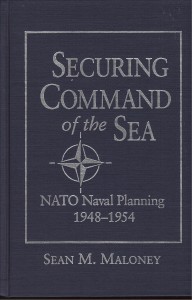
Abstract:
“Securing Command of the Sea” is the first history of the Cold War NATO naval command, Supreme Allied Commander Atlantic (SACLANT). The book provides details about the state of NATO and pre-NATO planning for war with the Soviet Union including how nuclear weapons would be used, and examines the internal struggle amongst the Western allies on how strategy would be formulated and how NATO forces would be commanded. The foreword was jointly written by Admiral of the Fleet, Sir Julian Oswald and former Chief of Naval Operations, Admiral Frank B. Kelso II of the US Navy.
Foreword Text:
It might be thought that in discussions to determine the command structure, the actual mechanism through which the strength of NATO members’ forces is exerted, military voices woule predominate. That this is far from the case is demonstrated by Sean Maloney in his detailed and thorough analysis of the genesis of NATO’s maritime command arrangements. It was international politics, at thehighest levels, that spoke the loudest. The author suggests that at times we were at great risk, because the temptation for the Soviets to intervene when alliance partners were clearly in disarray must have been very strong. But as the old English proverb goes. The proof of the pudding is in the eating. The Soviets did not attack, the chilly peace held, and now, forty years on, the threat is rapidly disappearing. Thus it can be argued that the command structures agreed upon by the fractious allies did meet the test-including perhaps the most dangerous incident of all, the Cuban Missile Crisis-albeit perhaps by a narrow margin.
An understanding of how we arrived where we are is not only interesting but of great value in relation to future changes. Command philosophy and organization can never stand still, as the demise of CHICHAN and the radical new arrangements recently introduced reveal. Nor will these be the last alterations, nor least because the pressure to downsize and economize is now very strong in all NATO countries.
While many aspects of NATO’s military organization have, understandably, remained classified until superseded (or even longer), the broad sweep of its grand strategy has always been common knowledge. No matter whether it was massive retaliation or flexible response, it was important in thelogic of deterrence for any potential aggressor to know that the alliance would respond and to judge that the response was plausible. Therefore, it is possible to assess the links between successive strategies and developments in command organization. To say the least, they were not always well aligned, as this book shows.
As one who has served in the NATO command structure in many ranks and who has held appointments as Principle Subordinate Commander in Striking Fleet Atlantic, Major Subordinate Commander to SACLANT, and Major NATO Commander (CINCHAN), I learned a great deal from this thorough, painstakingly researched investigative analysis.
-Julian Oswald, Admiral of the Fleet, Royal Navy
Sean Maloney has captured the politics and maritime arguments that made formulation of NATO’s naval commands so difficult. This book is a very fine reference for historians and practitioners of naval command. The reader will be amazed at the interest shown in NATO’s command structure by the military and political “giants” of the World War II era. This structure evolved and continues to evolve as changes take place in the NATO nations and the world. With every reorganization or realignment the command structure is evaluated and often altered, but each change is carefully examined by the nations and leaders of the alliance. Mr. Maloney has produced a fascinating document that should be studied by officers of the naval profession. I learned much from its well-written pages.
-Admiral Frank B. Kelso II, Chief of Naval Operations, USN (Ret.)
SCOTS also made the SHAPE Reading List